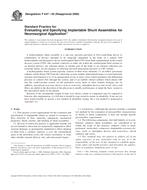Potrebujeme váš súhlas na využitie jednotlivých dát, aby sa vám okrem iného mohli ukazovať informácie týkajúce sa vašich záujmov. Súhlas udelíte kliknutím na tlačidlo „OK“.
ASTM F647-94(2006)
Standard Practice for Evaluating and Specifying Implantable Shunt Assemblies for Neurosurgical Application
Automaticky preložený názov:
Štandardná prax pre hodnotenie a určením implantovateľných Vypínacie zostavy pre Neurochirurgické Aplikácia
NORMA vydaná dňa 1.9.2006
Informácie o norme:
Označenie normy: ASTM F647-94(2006)
Poznámka: NEPLATNÁ
Dátum vydania normy: 1.9.2006
Kód tovaru: NS-55999
Počet strán: 12
Približná hmotnosť: 36 g (0.08 libier)
Krajina: Americká technická norma
Kategória: Technické normy ASTM
Anotácia textu normy ASTM F647-94(2006) :
Keywords:
anti-sipon device, bio-compatibility, compatibility, hydrocephalus, magnetic resonance imaging (MRI), shunt, shunt assembly, ICS Number Code 11.040.40 (Implants for surgery, prothetics and orthotics)
Doplňujúce informácie
| Significance and Use | ||||||||||||||||||||
|
This practice provides minimum requirements for the ensurance of safety and efficacy. It provides a common language whereby the function of these surgical implants is described. |
||||||||||||||||||||
| 1. Scope | ||||||||||||||||||||
|
1.1 This practice covers requirements for the evaluation and specification of implantable shunts as related to resistance to flow, direction of flow, materials, radiopacity, mechanical properties, finish, sterility, and labeling of shunt assemblies. 1.2 Devices to which this practice is applicable include, but are not limited to, those that are temporarily implanted to effect external drainage; or permanently implanted to effect shunting of fluid from a cerebral ventricle, a cyst, the subarachnoid space to the peritoneal cavity, the venous circulation, or some other suitable internal delivery site, and intracranial bypass. 1.3 Limitations Although this practice includes a standard test method for the evaluation of pressure/flow characteristics of shunts or shunt components, it does not include specific pressure/flow requirements. 1.4 The following components, that individually or in combination comprise shunt assemblies, are considered to be within the scope of this practice: catheters (such as atrial, peritoneal, ventricular), connectors, implantable accessory devices (such as antisiphon devices and reservoirs), valved catheters and valves. This standard does not purport to address all of the safety concerns, if any, associated with its use. It is the responsibility of the user of this standard to establish appropriate safety and health practices and determine the applicability of regulatory limitations prior to use. Note 1The following standards contain provisions that, through reference in this text, constitute provisions of this practice. At the time of publication, the editions indicated are valid. All standards are subject to revision, and parties to agreements based on this practice are encouraged to investigate the possibility of applying the most recent editions of the standards indicated below. Devices or components, or both, whose structures are comparable to that outlined in these standards are acceptable. 1.5 This test method provides the procedure and acceptance criteria upon which a judgment of acceptable radiopacity can be based and labeling claims substantiated. |
||||||||||||||||||||
| 2. Referenced Documents | ||||||||||||||||||||
|
Odporúčame:
Aktualizácia zákonov
Chcete mať istotu o platnosti využívaných predpisov?
Ponúkame Vám riešenie, aby ste mohli používať stále platné (aktuálne) legislatívne predpisy
Chcete vedieť viac informácií ? Pozrite sa na túto stránku.




 Cookies
Cookies
